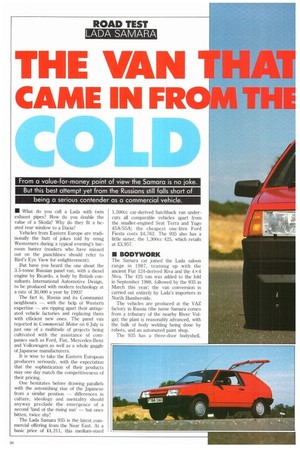THE VAN
Page 54

Page 55

If you've noticed an error in this article please click here to report it so we can fix it.
CAME IN FR
• What do you call a Lada with twin exhaust pipes? How do you double the value of a Skoda? Why do they fit a heated rear window to a Dacia?
Vehicles from Eastern Europe are traditionally the butt of jokes told by smug Westerners during a typical evening's barroom banter (readers who have missed out on the punchlines should refer to Bird's Eye View for enlightenment).
But have you heard the one about the 3.5-tonne Russian panel van, with a diesel engine by Ricardo, a body by British consultants International Automotive Design, to be produced with modern technology at a rate of 30,000 a year by 1993?
The fact is, Russia and its Communist neighbours — with the help of Western
expertise are ripping apart their antiquated vehicle factories and replacing them with efficient new ones. The panel van reported in Commercial Motor on 6 July is just one of a multitude of projects being cultivated with the assistance of companies such as Ford, Fiat, Mercedes-Benz and Volkswagen as well as a whole gaggle of Japanese manufacturers.
It is wise to take the Eastern European producers seriously, with the expectation that the sophistication of their products may one day match the competitiveness of their pricing.
One hestitates before drawing parallels with the astonishing rise of the Japanese from a similar position — differences in culture, ideology and mentality should anyway preclude the emergence of a second 'land of the rising sun' — but once bitten, twice shy!
The Lada Samara 935 is the latest commercial offering from the Near East. At a basic price of £4,211, this medium-sized 1,500cc car-derived hatchback van undercuts all comparable vehicles apart from the smaller-engined Seat Terra and Yugo 45A/55A; the cheapest one-litre Ford Fiesta costs £4,762. The 935 also has a little sister, the 1,300cc 425, which retails at £3,957.
The Samara car joined the Lada saloon range in 1987, teaming up with the ancient Fiat 124-derived Riva and the 4x4 Niva. The 425 van was added to the fold in September 1988, followed by the 935 in March this year; the van conversion is carried out entirely by Lada's importers in North Humberside.
The vehicles are produced at the VAZ factory in Russia (the name Samara comes from a tributary of the nearby River Volga); the plant is reasonably advanced, with the bulk of body welding being done by robots, and an automated paint shop.
The 935 has a three-door bodyshell, with pleasant and understated lines owing more to the late '70s than the late '80s. The only heavy-handed touch is an ugly plastic crustacean which has made its home between the headlights; all but the cheapest Samara saloons have acquired a simpler, more attractive replacement.
Access to the load area is through a tailgate mounted on gas struts. Having opened this, the Lada's biggest drawback becomes apparent: the loading lip is a massive 810mm above the ground.
Once the driver has avoided being poked in the eye by the tailgate, and has summoned the strength of a Soviet shotputter to heave the load aboard, there is a modest 1.06m3 of space to be filled: a task which is not helped by the awkward intrusion of the suspension struts.
The small operators who will probably be attracted to the Samara may well forgive the design deficiencies of the Lada's business end, but they are less likely to appreciate the atrocious finish inflicted on the unsuspecting Russian vehicle by the team of British 'craftsmen' who convert it into a van.
The screw heads carelessly covered with splodges of matt-black paint on the interior's side-protection panels are bad enough, but what really grates are the downright dangerous sharp edges left on the metal running strips on the load floor (unfortunately these strips have had to be cut in two to allow access to the spare wheel which is stowed beneath the load compartment floor).
Lada's importers owe the factory and their customers a little more care.
Plated at 1,370kg, the Samara has a potential payload of 395kg with a 75kg driver, but two factors prevent an owner taking advantage of this.
Firstly, it is all too easy to exceed the 710kg plated limit of the rear axle by placing the load too far back; secondly, the Samara makes do with the standard saloon suspension and the springs at the rear are too soft, allowing the hack of the body to slump down alarmingly in an ungainly posture.






























































































































































